Parameter Optimization of a Conveying and Separating Device Based on a Five-Stage Screw and Vibrating Screen for Tiger Nut Harvesters
Abstract
:1. Introduction
2. Materials and Methods
2.1. Agronomy and Plant Characteristics of Tiger Nuts
2.2. Overall Structure and Working Principle
2.2.1. Overall Structure of Conveying and Separating Device Test Bench
2.2.2. Working Principle
2.3. Parameter Design and Analysis of Key Components
2.3.1. Structure and Parameter Design of the Screw Conveyor
2.3.2. Analysis of the Material Conveying Process under Screw Action
2.3.3. Structure and Parameter Design of the Vibrating Screen Body
2.3.4. Analysis of the Material Separation Process under Vibration
3. Simulation Test and Result Analysis
3.1. Setting of Simulation Parameters and Model Construction
3.2. Analysis of Sand Particle Movements and Displacement Variation
3.2.1. Analysis of the Displacement Variation of Sand Particles along the X-axis
3.2.2. Analysis of Displacement Variation of Sand Particles along the Y-axis
3.2.3. Analysis of Displacement Variation of Sand Particles along the Z-axis
3.3. Bench Test
3.3.1. Test Materials and Equipment
3.3.2. Test Scheme
3.3.3. Evaluation Indicators
3.4. Test Results and Analysis
3.4.1. Test Design
3.4.2. Regression Variance Analysis of Conveying and Sand Removal Quality and Construction of Response Models
3.5. Analysis of the Influence of the Interaction of Key Parameters of the Conveying Device on Conveying and Sand Removal Quality
3.5.1. Analysis of the Influence Law of Significant Interaction Terms on the Sand Removal Rate Evaluation Indicator, R1
3.5.2. Analysis of the Influence Law of Significant Interaction Terms on the Evaluation Indicator Crushing Rate R2
3.5.3. Analysis of the Influence Law of Significant Interaction Terms on the Total Power Consumption Evaluation Indicator, R3
3.6. Optimization and Test Verification of Target Parameters
3.6.1. Optimization of Target Parameters
3.6.2. Test Verification
4. Conclusions
- A conveying and separating device combining screw conveying and a vibrating screen was designed for tiger nut harvesting. The conditions of axial and radial migration under the screw action and of the separation under vibratory action were analyzed. By simulating the separating process, the conveying and separating law of materials was clarified, and the rationality of the design was verified.
- A four-factor, five-level orthogonal central composite test was conducted. The test results were analyzed via the regression variance analysis method, and relation models between variable factors and evaluation indicators were constructed. The verification test results show that under the combined conditions of a screw velocity ratio of 0.88, an amplitude of 4.7 mm, a vibration frequency of 7.5 Hz, and a machine operation velocity of 0.92 km/h, the theoretical sand removal rate was 90.40%, the crushing rate was 1.66%, and the power consumption was 2.24 kW.
- The optimized results were verified via testing. The sand removal rate was 88.92%, the crushing rate was 1.71%, and the total power consumption was 2.29 kW. The errors from the predicted values were 1.6%, 3.0%, and 2.2%, respectively. A field performance test was carried out, and the conveying and separating device worked normally, meeting the requirements of conveying and separation for tiger nut harvesting.
Author Contributions
Funding
Data Availability Statement
Acknowledgments
Conflicts of Interest
References
- Zhao, X.Q.; Liu, H.; Lu, Z.Y.; Cheng, Y.C.; Zhang, D.J.; Bai, F.F.; Fang, J.; Ren, Y.F. Cultivation technology of windbreak and sand fixation of Tiger nut L. on desertified and degraded land. Mod. Agric. 2019, 6, 12–13. [Google Scholar] [CrossRef]
- Wang, R.Y.; Wang, X.S.; Xiang, H. A multi–purpose novel oil crop—Cyperus nuts. China Oils Fats 2019, 44, 1–4. [Google Scholar] [CrossRef]
- Sun, R.; Zhong, P.; Liu, Z.D.; Gao, H.J.; Wang, R.D.; Li, W.; You, H.Y.; Song, X.Y.; Wang, X.L. Research Progress on Stress Resistance of Tiger nut under Abiotic Stress. Feed. Feed. 2023, 5, 32–35. [Google Scholar] [CrossRef]
- Ding, L.; Guo, H.Q.; Wang, W.Z.; Lv, Z.J.; Lv, Y.L.; Zhang, R.K. Design and Test of Tiger nut Cell–wheel Seed–metering Device with Low–position Seeding and Cavitation Function. Trans. Chin. Soc. Agric. Mach. 2022, 53, 86–97. [Google Scholar]
- Yang, X.D.; Li, Z.Y. Tigernut industry in China: Current status of development, potential and adaptive suggestions. Chin. J. Oil Crop Sci. 2022, 44, 712–717. [Google Scholar] [CrossRef]
- Di, Z.F.; Li, Q.L.; Jiang, W.; Zhang, Z.Q.; Zhang, H.; Li, N.; Cui, D.K.; Zhou, J. Research advance and perspective of Tiger nut planting and harvesting machinery technology and equipment. J. Shanxi Agric. Univ. Nat. Sci. Ed. 2022, 42, 96–106. [Google Scholar] [CrossRef]
- Zhao, Z.; He, X.N.; Wang, D.W.; Shang, S.Q.; Xu, N.; Zhu, H.; Zheng, X.S. Design and Test of the Anti–rotation Throwing Device of the Cyperus Edulis Combine Harvester. J. Agric. Mech. Res. 2023, 45, 172–176+182. [Google Scholar] [CrossRef]
- He, X.; Lv, Y.; Qu, Z.; Wang, W.; Zhou, Z.; He, H. Parameters optimization and test of caterpillar self–Propelled Tiger nut harvester hoisting device. Agriculture 2022, 12, 1060. [Google Scholar] [CrossRef]
- Liu, X.M.; Liu, Z.H.; Liang, Y.; Xiao, S.P. Development of multifunctional harvesting machine based on modular theory. Chin. Agric. Mech. 2012, 47–50. [Google Scholar] [CrossRef]
- Wanfangdata. Available online: https://d.wanfangdata.com.cn/patent/ChJQYXRlbnROZXdTMjAyMzA5MDESEENOMjAxODIxMTUxMDUwLlgaCDc2OW16bnR1 (accessed on 30 April 2019).
- Wanfangdata. Available online: https://d.wanfangdata.com.cn/patent/ChJQYXRlbnROZXdTMjAyMzA5MDESEENOMjAyMDEwNzczMDI5LjkaCHpzeTJvZzNl (accessed on 9 October 2020).
- Wanfangdata. Available online: https://d.wanfangdata.com.cn/patent/ChJQYXRlbnROZXdTMjAyMzA5MDESEENOMjAxNzEwMTIyMTc0LjkaCDdhNTVpZjU0 (accessed on 31 May 2017).
- Zhang, Z.G.; Wang, F.A.; Zhang, Y.C.; Zhang, D.; Tian, R. Design and Experiment of Self–propelled Panax notoginseng Harvester. Trans. Chin. Soc. Agric. Mach. 2016, 47, 234–240. [Google Scholar]
- Zhang, Z.G.; Du, Z.L.; Cui, Z.M.; Liu, W.J.; Pan, R. Motion Analysis and Simulation Test of Digging and Soil Separating Device of Panax notoginseng Harvester. J. Kunming Univ. Sci. Technol. Nat. Sci. 2019, 44, 41–51. [Google Scholar] [CrossRef]
- Wei, Z.C.; Li, H.W.; Su, G.L.; Sun, C.Z.; Liu, W.Z.; Li, X.Q. Development of potato harvester with buffer type potato–impurity separation sieve. Trans. Chin. Soc. Agric. Eng. Trans. CSAE 2019, 35, 1–11. [Google Scholar] [CrossRef]
- Lv, J.Q.; Tian, Z.E.; Wu, J.E. Design and experiment on 4U1Z vibrating potato digger. Trans. Chin. Soc. Agric. Eng. Trans. CSAE 2015, 31, 39–47. [Google Scholar] [CrossRef]
- Wei, H.A.; Zhang, J.L.; Yang, X.P.; Huang, X.L.; Dai, L.X.; Sun, G.H.; Liu, X. Improved design and test of 4UFD–1400 type potato combine harvester. Trans. Chin. Soc. Agric. Eng. Trans. CSAE 2014, 30, 12–17. [Google Scholar] [CrossRef]
- Hu, Z.C.; Chen, Y.Q.; Wang, H.O. Design and experimental research on vibrating type peanut harvester. Trans. CSAE 2008, 24, 14–117. [Google Scholar]
- Wang, D.W.; Shang, S.Q.; Li, X.; Gao, D.X. Type–L Cleaning Separation Mechanism of Peanut Combine Harvester. Trans. Chin. Soc. Agric. Mach. 2013, 44, 68–74+51. [Google Scholar] [CrossRef]
- Liao, X.T.; Xiao, F.Z.; Wang, K.P.; Cai, Y.; LI, D.D. Technical features and useing adjustment of 4HZJ–2500 type self–propelled peanut picking harvester. Agric. Henan 2023, 2, 56–58. [Google Scholar] [CrossRef]
- Lian, G.D.; Zong, W.Y.; Feng, W.; Ma, L.N.; Cheng, Y.F.; Wei, X.X. Design and Experiment of Cutting Threshing Integrated Type Header for Harvesting of Edible Sunflower. Trans. Chin. Soc. Agric. Mach. 2023, 54, 122–131+154. [Google Scholar]
- Jiang, E.C.; Su, X.L.; Wang, M.F.; Xiong, L.M.; Zhao, C.; Xu, X.W. Design of Variable Pitch Spiral Conveyor for Biomass Continual Pyrolysis Reactor. Trans. Chin. Soc. Agric. Mach. 2013, 44, 121–124. [Google Scholar] [CrossRef]
- Huang, X.Q. Transport Machinery Selection and Design Manual; Chemical Industry Press: Beijing, China, 2011. [Google Scholar]
- Hou, S.Y.; Chen, H.T. Parameters optimization of vertical axial flow thresher for soybean breeding. Trans. Chin. Soc. Agric. Eng. (Trans. CSAE) 2012, 28, 19–25. [Google Scholar] [CrossRef]
- Mei, X.; Zheng, Y.; Liu, H.Y.; Dong, D.S. Kinematic Analysis of Particles in the Vertical Screw Conveyor. Mach. Des. Manuf. 2017, 7, 26–29. [Google Scholar] [CrossRef]
- Lian, G.D.; Wei, X.X.; Ma, L.N.; Zhou, G.H.; Zong, W.Y. Design and experiments of the axial–flow spiral drum threshing device for the edible sunflower. Trans. Chin. Soc. Agric. Eng. Trans. CSAE 2022, 38, 42–51. [Google Scholar] [CrossRef]
- Huang, J.Y. Design and Analysis of Spiral Fruit and Vegetable Waste Compressor. Master’s Thesis, Xi’an University of Technology, Xi’an, China, 2021. [Google Scholar] [CrossRef]
- Jin, C.H.; Zhang, Z.; Liu, S.; Zhou, W.J.; Fu, J. Design of a Delayed Tumbling Device for Screening Inferior Cigarette Paper Flowers and Tobacco Shreds. Plant Maint. Eng. 2023, 4, 133–135. [Google Scholar] [CrossRef]
- Feng, X. Study on Working Mechanism and Structural Optimization Design of Cleaning Device in Maize Grain Combine Harvester. Ph.D. Thesis, Northeast Agricultural University, Harbin, China, 2020. [Google Scholar] [CrossRef]
- Sun, H. Principle of Mechanics; Higher Education Publishing House: Beijing, China, 2013. [Google Scholar]
- Cheng, Y.F. Structural Optimization Design and Modal Analysis of Linear Vibrating Screen. Master’s Thesis, Taiyuan University of Technology, Taiyuan, China, 2015. [Google Scholar]
- Zeng, J. Research on Vibrating Screen Driven by Eccentric Cam Mechanism. Master’s Thesis, Southwest Petroleum University, Chengdu, China, 2019. [Google Scholar] [CrossRef]
- Xu, T.H. A comparative study on the efficiency of vibration screening parameters based on EDEM. China South Agric. Mach. 2024, 55, 166–168. [Google Scholar] [CrossRef]
- Hou, J.M.; Ren, Z.T.; Zhu, H.J. Design and Test of double–layer inclined vibrating Air–screen Castor cleaning device. Trans. Chin. Soc. Agric. Mach. 2022, 53, 39–51. [Google Scholar] [CrossRef]
- Zheng, X.S.; Shang, S.Q.; Wang, D.W.; Li, C.P.; Li, M.H.; Shen, S.L.; Zhao, Z.L.; He, X.N. Design analysis and test of air–screen type oil sedge cleaning device. J. Agric. Mech. Res. 2024, 46, 146–153+159. [Google Scholar] [CrossRef]
- Jin, T.C. Development of a Potato Soil Vibration Separation Test Platform for Mechanized Harvesting of Potatoes. Master’s Thesis, Shenyang Agricultural University, Shenyang, China, 2023. [Google Scholar] [CrossRef]
- Qi, J.T.; An, S.G.; Kan, Z.; Meng, H.W.; Li, Y.P.; Zhao, X.Y. Discrete element–based calibration of simulation parameters of Cyperus esculentus L. (Tiger nut) planted in sandy soil. J. Food Process. Preserv. 2021, 45, e15631. [Google Scholar] [CrossRef]
- Ucgul, M.; Fielke, J.M.; Saunders, C. Three–dimensional discrete element modeling of tillage: Determination of a suitable contact model and parameters for a cohesionless soil. Biosyst. Eng. 2014, 121, 105–117. [Google Scholar] [CrossRef]
- Ucgul, M.; Fielke, J.M.; Saunders, C. Defining the effect of sweep tillage tool cutting edge geometry on tillage forces using 3D discrete element modeling. Inf. Process. Agric. 2015, 2, 130–141. [Google Scholar] [CrossRef]
- Zhang, R.; Han, D.L.; Ji, Q.L.; He, Y.; Li, J.Q. Calibration Methods of Sandy Soil Parameters in Simulation of Discrete Element Method. Trans. Chin. Soc. Agric. Mach. 2017, 48, 49–56. [Google Scholar] [CrossRef]
- Dun, G.Q.; Yu, C.L.; Yang, Y.Z.; Ye, J.; Du, J.X.; Zhang, J.T. Parameter simulation optimization and experiment of seed plate type hole for soybean breeding. Trans. Chin. Soc. Agric. Eng. 2019, 35, 62–73. [Google Scholar] [CrossRef]
- Hao, J.J.; Nie, Q.L.; Ma, L.P.; Li, J.C.; Song, Y.H.; Long, S.F. Development of cone disc type shelling mechanism for pcanut seeds. Trans. Chin. Soc. Agric. Eng. 2020, 36, 27–34. [Google Scholar] [CrossRef]
- Wang, F.A.; Wen, B.; Xie, X.D.; Xie, K.T.; Guo, S.W.; Zhang, Z.G. Operation Mechanism Analysis and Parameter Optimization of Conveying and Separating Device of Panax notoginseng Harvester. Trans. Chin. Soc. Agric. Mach. 2023, 54, 201–211+259. [Google Scholar] [CrossRef]
- Jin, Z. Simulation and Experiment of the Conveying and Removing Device on Corn Stalk Granulator. Master’s Thesis, Shenyang Agricultural University, Shenyang, China, 2021. [Google Scholar] [CrossRef]
- Lv, J.Q.; Sun, H.; Dui, H.; Peng, M.M.; Yu, J.Y. Design and Experiment on Conveyor Separation Device of Potato Digger under Heavy Soil Condition. Trans. Chin. Soc. Agric. Mach. 2017, 48, 146–155. [Google Scholar] [CrossRef]
- Zhang, S.W.; Zhang, R.Y.; Cao, Q.Q.; Zhang, Y.; Fu, J.; Yuan, H.F. Design and Experiment of Double–deck Roller Sieve Type Fruit Impurity Separation Device for Tiger nut Harvester. Trans. Chin. Soc. Agric. Mach. 2023, 54, 148–157. [Google Scholar]
- GB/T 5262-2008; Agricultural Machinery Testing Conditions-General Rules for Measuring Methods. Standards Press of China: Beijing, China, 2008. Available online: https://openstd.samr.gov.cn/bzgk/gb/newGbInfo?hcno=24242BA41C6C88B16F72B808459C3A4F (accessed on 10 February 2024).
- DB34/T 534-2022; Technical Specification for Peanut Harvesting Mechanization. Anhui Market Supervision Administration Bureau: Anhui, China, 2022. Available online: http://down.foodmate.net/standard/sort/15/118034.html (accessed on 10 February 2024).




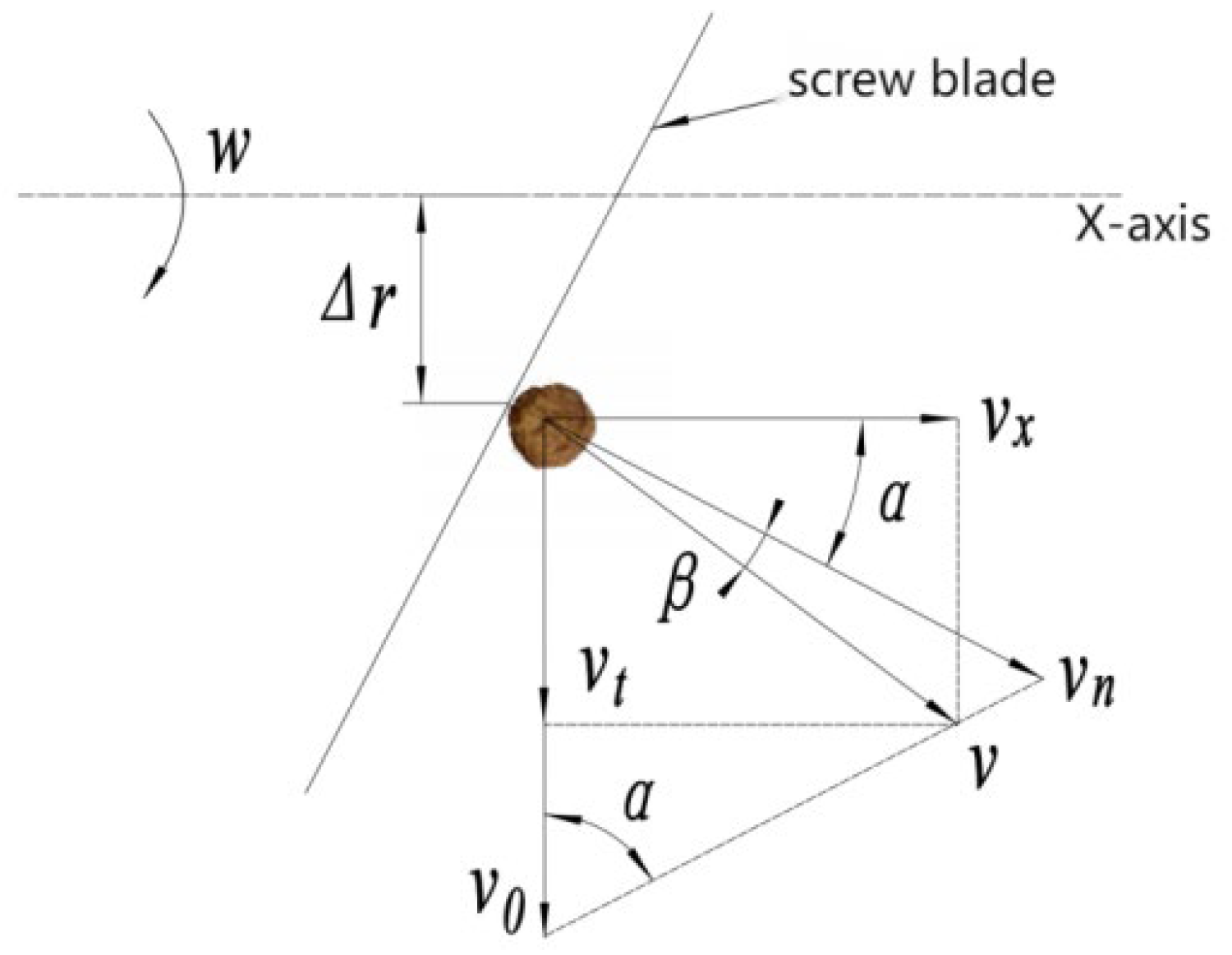
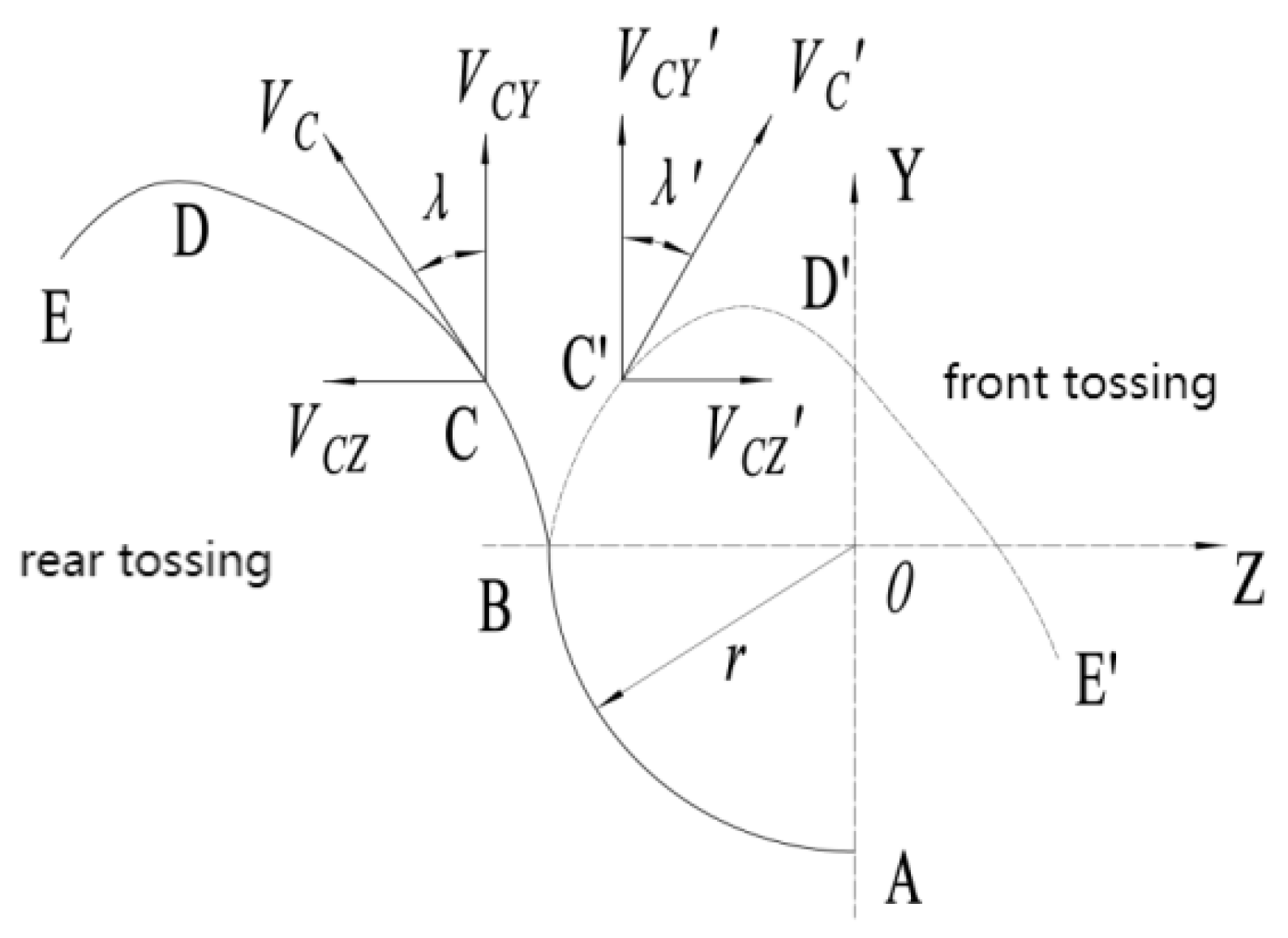

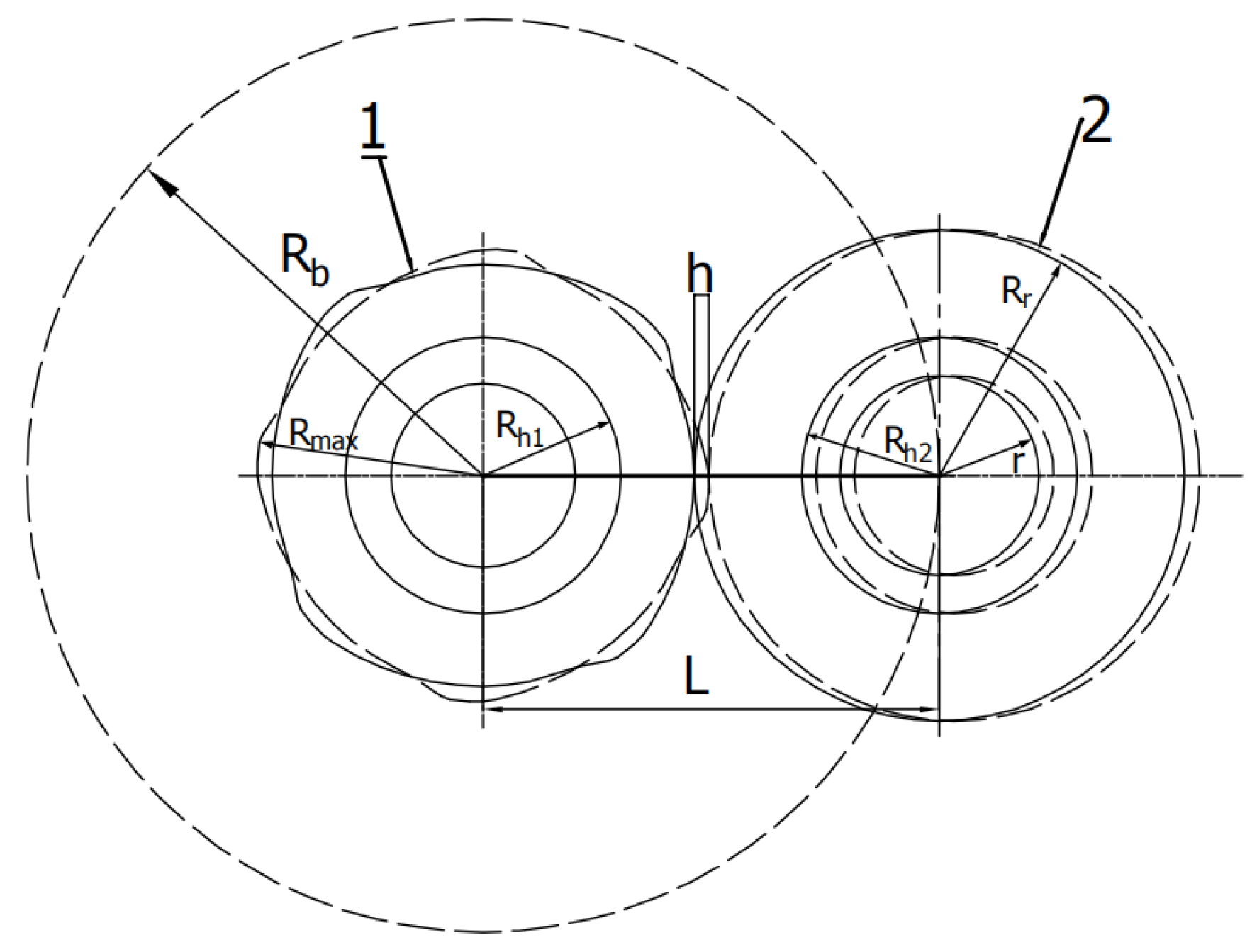


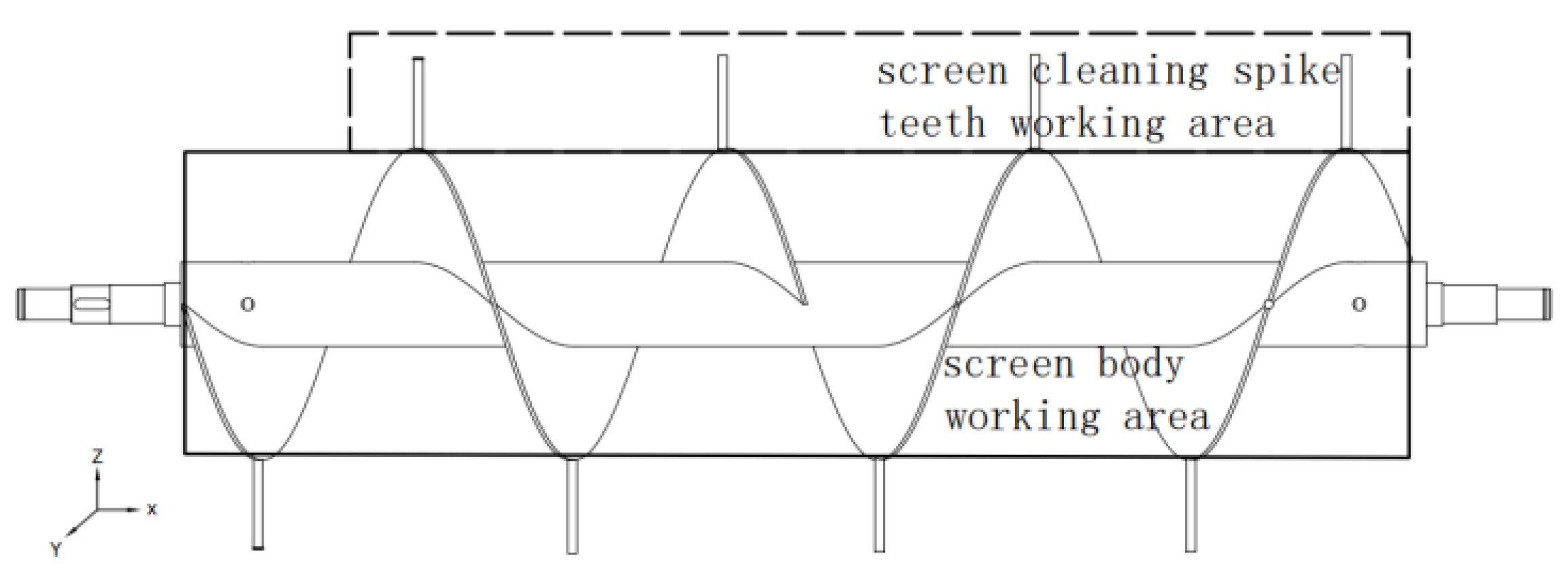


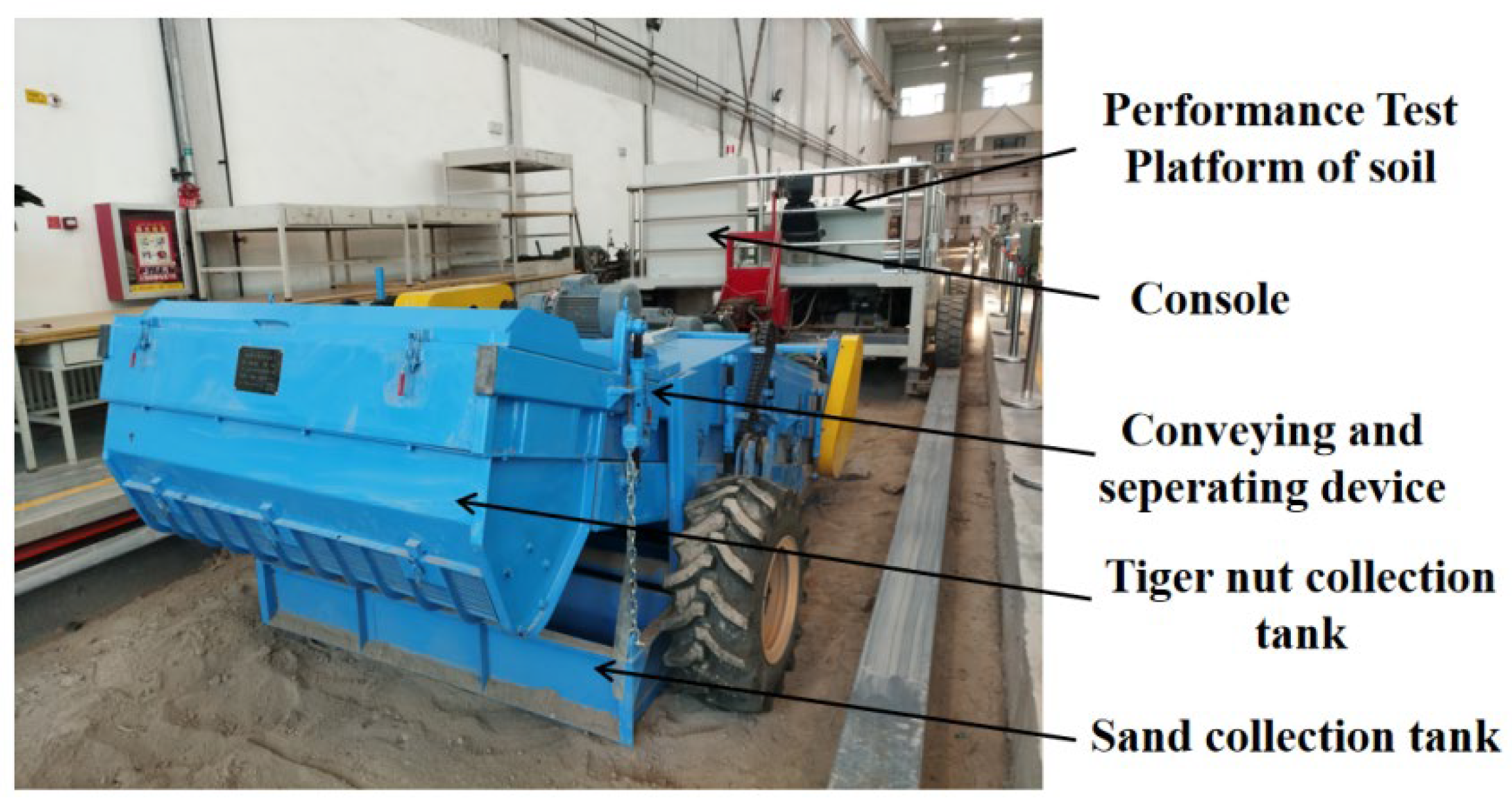




| Parameter | Average Value |
|---|---|
| Root and stem diameter/mm | 5.2 |
| Root and stem height/mm | 84 |
| Depth of complex growth/mm | 114 |
| Moisture content of tiger nut/% | 11.2 |
| Moisture content of sand/% | 6.5 |
| Parameter | Numerical Value |
|---|---|
| Length × width × height/(mm × mm × mm) | 4900 × 2600 × 1600 |
| Working width/mm | 1600 |
| Total power/kW | 33 |
| Frequency adjustment range/Hz | 0~25 |
| Adjustment range of conveying speed/(r/min) | 0~380 |
| Material | Poisson’s Ratio | Density (kg/m3) | Elasticity Modulus (Mpa) |
|---|---|---|---|
| Sand Particles | 0.3 | 1638 | 29.9 |
| Tiger Nuts | 0.41 | 1089 | 1.5 × 102 |
| Geometry | 0.28 | 7850 | 2.099 × 103 |
| Contact | Contact Type | ||
|---|---|---|---|
| Recovery Coefficient | Coefficient of Static Friction | Coefficient of Rolling Friction | |
| Tiger Nut and Tiger Nut | 0.43 | 0.48 | 0.05 |
| Tiger Nut and Steel | 0.45 | 0.41 | 0.06 |
| Roots and Roots | 0.60 | 0.33 | 0.14 |
| Roots and Steel | 0.31 | 0.41 | 0.01 |
| Speed Ratio | First-Stage Screw Conveyor (r/min) | Second-Stage Screw Conveyor (r/min) | Third-Stage Screw Conveyor (r/min) | Fourth-Stage Screw Conveyor (r/min) | Fifth-Stage Screw Conveyor (r/min) |
|---|---|---|---|---|---|
| 0.8 | 280 | 224 | 179 | 179 | 179 |
| 0.85 | 280 | 238 | 202 | 202 | 202 |
| 0.9 | 280 | 252 | 227 | 227 | 227 |
| 0.95 | 280 | 266 | 253 | 253 | 253 |
| 1 | 280 | 280 | 280 | 280 | 280 |
| Code | Amplitude/(mm) | Vibration Frequency/(Hz) | Machine Operation Velocity/(km/h) |
|---|---|---|---|
| −2 | 1.5 | 5 | 0.6 |
| −1 | 3 | 6 | 0.8 |
| 0 | 4.5 | 7 | 1 |
| 1 | 6 | 8 | 1.2 |
| 2 | 7.5 | 9 | 1.4 |
| Test Serial Number | Speed Ratio | Amplitude (mm) | Vibration Frequency (Hz) | Machine Operation velocity/(km/h) | Cleaning Ratio/% | Crushing Ratio/% | Total Power Consumption/kW |
|---|---|---|---|---|---|---|---|
| 1 | −1 | −1 | −1 | −1 | 73.12 | 1.49 | 2.46 |
| 2 | 1 | −1 | −1 | −1 | 80.77 | 2.98 | 2.71 |
| 3 | −1 | 1 | −1 | −1 | 80.06 | 2.22 | 1.56 |
| 4 | 1 | 1 | −1 | −1 | 84.86 | 2.47 | 3.06 |
| 5 | −1 | −1 | 1 | −1 | 80.84 | 1.41 | 2.02 |
| 6 | 1 | −1 | 1 | −1 | 84.22 | 3.42 | 2.28 |
| 7 | −1 | 1 | 1 | −1 | 87.46 | 1.88 | 1.44 |
| 8 | 1 | 1 | 1 | −1 | 88.98 | 3.28 | 2.93 |
| 9 | −1 | −1 | −1 | 1 | 86.15 | 1.19 | 3.84 |
| 10 | 1 | −1 | −1 | 1 | 86.69 | 1.94 | 2.82 |
| 11 | −1 | 1 | −1 | 1 | 86.23 | 0.86 | 3.6 |
| 12 | 1 | 1 | −1 | 1 | 86.87 | 0.74 | 3.42 |
| 13 | −1 | −1 | 1 | 1 | 80.95 | 1.72 | 3.28 |
| 14 | 1 | −1 | 1 | 1 | 84.94 | 2.95 | 2.08 |
| 15 | −1 | 1 | 1 | 1 | 81.44 | 2.92 | 2.79 |
| 16 | 1 | 1 | 1 | 1 | 85.84 | 1.51 | 2.39 |
| 17 | −2 | 0 | 0 | 0 | 79.71 | 2.6 | 3.1 |
| 18 | 2 | 0 | 0 | 0 | 80.01 | 2.87 | 3.04 |
| 19 | 0 | −2 | 0 | 0 | 75.93 | 2.62 | 2.98 |
| 20 | 0 | 2 | 0 | 0 | 81.67 | 2.35 | 3.07 |
| 21 | 0 | 0 | −2 | 0 | 80.68 | 0.51 | 2.99 |
| 22 | 0 | 0 | 2 | 0 | 90.65 | 2.85 | 2.11 |
| 23 | 0 | 0 | 0 | −2 | 80.81 | 2.57 | 2.58 |
| 24 | 0 | 0 | 0 | 2 | 84.42 | 1.39 | 3.12 |
| 25 | 0 | 0 | 0 | 0 | 90.55 | 1.55 | 2.74 |
| 26 | 0 | 0 | 0 | 0 | 91.21 | 1.36 | 2.48 |
| 27 | 0 | 0 | 0 | 0 | 92.98 | 1.83 | 2.55 |
| 28 | 0 | 0 | 0 | 0 | 89.62 | 1.11 | 2.52 |
| 29 | 0 | 0 | 0 | 0 | 90.42 | 1.76 | 2.45 |
| 30 | 0 | 0 | 0 | 0 | 89.46 | 0.91 | 2.31 |
| Experimental Indicators | Source of Variance | Sum of Squares | Freedom | Mean Square | F | p | Significance |
|---|---|---|---|---|---|---|---|
| R1 | Model | 597.89 | 14 | 42.71 | 8.26 | 0.0001 | Significant |
| X1 | 31.56 | 1 | 31.56 | 6.1 | 0.026 | * | |
| X2 | 52.63 | 1 | 52.63 | 10.18 | 0.0061 | ** | |
| X3 | 37.15 | 1 | 37.15 | 7.19 | 0.0171 | * | |
| X4 | 28.21 | 1 | 28.21 | 5.46 | 0.0338 | * | |
| X1X2 | 1.1 | 1 | 1.1 | 0.21 | 0.6508 | ||
| X1X3 | 7.23 × 10−3 | 1 | 7.23 × 10−3 | 1.40 × 10−3 | 0.9707 | ||
| X1X4 | 3.78 | 1 | 3.78 | 0.73 | 0.4058 | ||
| X2X3 | 0.14 | 1 | 0.14 | 0.026 | 0.8729 | ||
| X2X4 | 26.94 | 1 | 26.94 | 5.21 | 0.0375 | * | |
| X3X4 | 78.59 | 1 | 78.59 | 15.2 | 0.0014 | ** | |
| X12 | 155.61 | 1 | 155.61 | 30.1 | <0.0001 | ** | |
| X22 | 192.16 | 1 | 192.16 | 37.17 | <0.0001 | ** | |
| X32 | 23.75 | 1 | 23.75 | 4.6 | 0.0489 | * | |
| X42 | 78.63 | 1 | 78.63 | 15.21 | 0.0014 | ** | |
| Residual | 77.54 | 15 | 5.17 | ||||
| Lack of Fit | 69.28 | 10 | 6.93 | 4.19 | 0.0636 | Not Significant | |
| Pure Error | 8.26 | 5 | 1.65 | ||||
| Cor Total | 675.43 | 29 | |||||
| R2 | 0.8852 | CV | 2.69% | Adeq Precision | 10.45 | ||
| R2 | Model | 16.37 | 14 | 1.17 | 6.56 | 0.0004 | Significant |
| X1 | 1.57 | 1 | 1.57 | 8.81 | 0.0096 | ** | |
| X2 | 0.13 | 1 | 0.13 | 0.72 | 0.4082 | ||
| X3 | 4.07 | 1 | 4.07 | 22.82 | 0.0002 | ** | |
| X4 | 2.46 | 1 | 2.46 | 13.79 | 0.0021 | ** | |
| X1X2 | 1.8 | 1 | 1.8 | 10.07 | 0.0063 | ** | |
| X1X3 | 0.046 | 1 | 0.046 | 0.26 | 0.618 | ||
| X1X4 | 1.38 | 1 | 1.38 | 7.75 | 0.0139 | * | |
| X2X3 | 0.12 | 1 | 0.12 | 0.69 | 0.4201 | ||
| X2X4 | 0.34 | 1 | 0.34 | 1.89 | 0.1897 | ||
| X3X4 | 0.78 | 1 | 0.78 | 4.39 | 0.0534 | ||
| X12 | 2.51 | 1 | 2.51 | 14.06 | 0.0019 | ** | |
| X22 | 1.58 | 1 | 1.58 | 8.85 | 0.0094 | ** | |
| X32 | 0.041 | 1 | 0.041 | 0.23 | 0.6395 | ||
| X42 | 0.35 | 1 | 0.35 | 1.98 | 0.1794 | ||
| Residual | 2.67 | 15 | 0.18 | ||||
| Lack of Fit | 2.01 | 10 | 0.2 | 1.52 | 0.3355 | Not Significant | |
| Pure Error | 0.66 | 5 | 0.13 | ||||
| Cor Total | 19.05 | 29 | |||||
| R2 | 0.8596 | CV | 21.37% | Adeq Precision | 9.965 | ||
| R3 | Model | 7.89 | 14 | 0.56 | 10.93 | <0.0001 | Significant |
| X1 | 0.014 | 1 | 0.014 | 0.27 | 0.6097 | ||
| X2 | 6.00 × 10−4 | 1 | 6.00 × 10−4 | 0.012 | 0.9155 | ||
| X3 | 1.51 | 1 | 1.51 | 29.29 | <0.0001 | ** | |
| X4 | 1.95 | 1 | 1.95 | 37.81 | <0.0001 | ** | |
| X1X2 | 1.06 | 1 | 1.06 | 20.58 | 0.0004 | ** | |
| X1X3 | 0.01 | 1 | 0.01 | 0.19 | 0.6659 | ||
| X1X4 | 2.48 | 1 | 2.48 | 48.12 | <0.0001 | ** | |
| X2X3 | 4.00 × 10−4 | 1 | 4.00 × 10−4 | 7.76 × 10−3 | 0.931 | ||
| X2X4 | 0.027 | 1 | 0.027 | 0.53 | 0.4786 | ||
| X3X4 | 0.26 | 1 | 0.26 | 4.95 | 0.0419 | * | |
| X12 | 0.31 | 1 | 0.31 | 5.98 | 0.0273 | * | |
| X22 | 0.25 | 1 | 0.25 | 4.78 | 0.045 | * | |
| X32 | 0.016 | 1 | 0.016 | 0.31 | 0.5887 | ||
| X42 | 0.071 | 1 | 0.071 | 1.39 | 0.2574 | ||
| Residual | 0.77 | 15 | 0.052 | ||||
| Lack of Fit | 0.67 | 10 | 0.067 | 3.4 | 0.0944 | Not Significant | |
| Pure Error | 0.099 | 5 | 0.02 | ||||
| Cor Total | 8.66 | 29 | |||||
| R2 | 0.911 | CV | 8.44% | Adeq Precision | 14.538 |
Disclaimer/Publisher’s Note: The statements, opinions and data contained in all publications are solely those of the individual author(s) and contributor(s) and not of MDPI and/or the editor(s). MDPI and/or the editor(s) disclaim responsibility for any injury to people or property resulting from any ideas, methods, instructions or products referred to in the content. |
© 2024 by the authors. Licensee MDPI, Basel, Switzerland. This article is an open access article distributed under the terms and conditions of the Creative Commons Attribution (CC BY) license (https://creativecommons.org/licenses/by/4.0/).
Share and Cite
Qi, J.; Gao, J.; Chen, S.; Chen, W.; Yang, L.; Meng, H.; Kan, Z. Parameter Optimization of a Conveying and Separating Device Based on a Five-Stage Screw and Vibrating Screen for Tiger Nut Harvesters. Agriculture 2024, 14, 682. https://doi.org/10.3390/agriculture14050682
Qi J, Gao J, Chen S, Chen W, Yang L, Meng H, Kan Z. Parameter Optimization of a Conveying and Separating Device Based on a Five-Stage Screw and Vibrating Screen for Tiger Nut Harvesters. Agriculture. 2024; 14(5):682. https://doi.org/10.3390/agriculture14050682
Chicago/Turabian StyleQi, Jiangtao, Jianping Gao, Shan Chen, Wenhui Chen, Luoyi Yang, Hewei Meng, and Za Kan. 2024. "Parameter Optimization of a Conveying and Separating Device Based on a Five-Stage Screw and Vibrating Screen for Tiger Nut Harvesters" Agriculture 14, no. 5: 682. https://doi.org/10.3390/agriculture14050682





